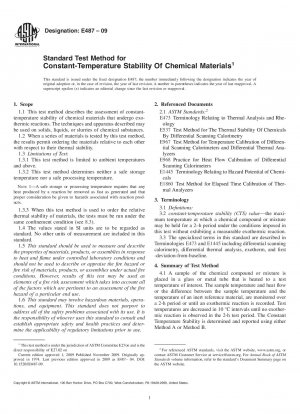ASTM E487-09
Standard Test Method for Constant-Temperature Stability Of Chemical Materials
- Standard No.
- ASTM E487-09
- Release Date
- 2009
- Published By
- American Society for Testing and Materials (ASTM)
- Status
- Replace By
- ASTM E487-14
- Latest
- ASTM E487-20
- Scope
This test method is a useful adjunct to dynamic thermal tests that are performed under conditions in which the sample temperature is increased continuously at a programmed rate. Results obtained under dynamic test conditions present difficulties in determining the temperature at which an exotherm initiates because onset temperature is dependent on heating rate. The test method described in the present standard attempts to determine the onset temperature under isothermal conditions where the heating rate is zero.
1.1 This test method describes the assessment of constant-temperature stability of chemical materials that undergo exothermic reactions. The techniques and apparatus described may be used on solids, liquids, or slurries of chemical substances.
1.2 When a series of materials is tested by this test method, the results permit ordering the materials relative to each other with respect to their thermal stability.
1.3 Limitations of Test:
1.3.1 This test method is limited to ambient temperatures and above.
1.3.2 This test method determines neither a safe storage temperature nor a safe processing temperature.
Note 18212;A safe storage or processing temperature requires that any heat produced by a reaction be removed as fast as generated and that proper consideration be given to hazards associated with reaction products.
1.3.3 When this test method is used to order the relative thermal stability of materials, the tests must be run under the same confinement condition (see 8.3).
1.4 The values stated in SI units are to be regarded as standard. No other units of measurement are included in this standard.
1.5 This standard should be used to measure and describe the properties of materials, products, or assemblies in response to heat and flame under controlled laboratory conditions and should not be used to describe or appraise the fire hazard or fire risk of materials, products, or assemblies under actual fire conditions. However, results of this test may be used as elements of a fire risk assessment which takes into account all of the factors which are pertinent to an assessment of the fire hazard of a particular end use.
1.6 This standard may involve hazardous materials, operations, and equipment. This standard does not purport to address all of the safety problems associated with its use. It is the responsibility of whoever uses this standard to consult and establish appropriate safety and health practices and determine the applicability of regulatory limitations prior to use.
ASTM E487-09 Referenced Document
- ASTM E1445 Standard Terminology Relating to Hazardous Potential of Chemicals
- ASTM E1860 Standard Test Method for Elapsed Time Calibration Thermal Analyzers
- ASTM E473 Standard Terminology Relating to Thermal Analysis
- ASTM E537 Standard Test Method for Assessing the Thermal Stability of Chemicals By Methods of Thermal Analysis
- ASTM E967 Standard Practice for Temperature Calibration of Differential Scanning Calorimeters and Differential Thermal Analyzers
- ASTM E968 Standard Practice for Heat Flow Calibration of Differential Scanning Calorimeters
ASTM E487-09 history
- 2020 ASTM E487-20 Standard Test Methods for Constant-Temperature Stability of Chemical Materials
- 2014 ASTM E487-14 Standard Test Method for Constant-Temperature Stability of Chemical Materials
- 2009 ASTM E487-09 Standard Test Method for Constant-Temperature Stability Of Chemical Materials
- 2004 ASTM E487-04 Standard Test Method for Constant-Temperature Stability Of Chemical Materials
- 1999 ASTM E487-99 Standard Test Method for Constant-Temperature Stability Of Chemical Materials
